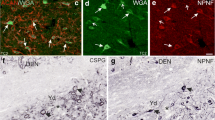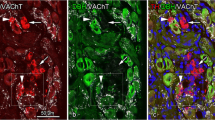Summary
Morphology and ultrastructure of special cell groups in the ganglion vestibulare are investigated. It is supposed that the disseminated cell groups represent a nonchromaffin parasympathogenic paraganglion vestibulare belonging to the Rr. communicantes cum N. statoacustico of the N. facialis. A neurosecretory function of the paraganglion vestibulare is discussed.
Zusammenfassung
Im Ganglion vestibulare der Maus recht inkonstant vorkommende besondere Zellknötchen wurden licht- und elektronenmikroskopisch untersucht. Es wird angenommen, daß die disseminiert auftretenden Zellgruppen ein nicht-chromaffines, parasympathogenes Paraganglion vestibulare darstellen, das den aus der Pars intermedia des N. facialis abgehenden Rr. communicantes cum N. statoacustico angehört. Diesem Paraganglion vestibulare wird eine (neuro-)sekretorische Funktion unterstellt und die Bedeutung der Paraganglien allgemein erörtert.
Similar content being viewed by others
Literatur
Ábrahám, A.: Electron microscopic investigations on the human carotid body (preliminary communication). Z. mikr.-anat. Forsch. 79, 309–315 (1968).
Adams, W. E.: The carotid sinus complex in the hedgehog, Erinaceus europaeus. J. Anat. (Lond.) 91, 207–227 (1957).
Al-Lami, F., Murray, R. G.: Fine structure of the carotid body of normal and anoxic cats. Anat. Rec. 160, 697–717 (1968a).
Al-Lami, F., Murray, R. G.: Fine structure of carotid body of Macaca mulatta Monkey. J. Ultrastruct. Res. 24, 465–478 (1968b).
Andrzejewski, C.: Histologische Studien zur vegetativen und cerebralen Innervation des Innenohres und seiner Gefäße beim Menschen und Hund. Z. Zellforsch. 42, 1–18 (1955).
Arnold, M., Hager, G.: Funktionsentwicklung der Nebenniere beim Goldhamster. Z. Zellforsch. 83, 117–132 (1967).
Battaglia, G.: Ultrastructural observations on the biogenic amines in the carotid and aorticabdominal bodies of the human fetus. Z. Zellforsch. 99, 529–537 (1969).
Benedeczky, I., Puppi, A., Tigyi, A., Lissák, K.: Various cell types in the adrenal medulla. Nature (Lond.) 209, 592–514 (1966).
Benninghoff, A.: Lehrbuch der Anatomie des Menschen, Bd. 2. Berlin-München: Urban & Schwarzenberg 1948.
Biscoe, T. J., Stehbens, W. E.: Ultrastructure of the carotid body. J. Cell Biol. 30, 563–578 (1966).
Blaschko, H., Hagen, P., Welch, A. D.: Observations on intracellular granules of the adrenal medulla. J. Physiol. (Lond.) 129, 27–49 (1955).
Blümcke, S., Rode, J., Niedorf, H. R.: The carotid body after oxygen defiency. Z. Zellforsch. 80, 52–77 (1967).
Böck, P.: Die Feinstruktur des paraganglionären Gewebes im Plexus suprarenalis des Meerschweinchens. Z. Zellforsch. 105, 389–404 (1970a).
Böck, P., Stockinger, L., Vyslonzil, E.: Die Feinstruktur des Glomus caroticum beim Menschen. Z. Zellforsch. 105, 543–568 (1970).
Bötner, V.: Studio anatomo-comparativo sulle anastomosi vestibolo-faciali. Valsalva 31, 187–191 (1955).
Bogomolez: Zit. nach Watzka (1955).
Cajal, S. R.: Histologie du système nerveux 2. Paris: Maloine 1911.
Chen, I-Li, Yates, R. D., Duncan, D.: Electron microscope localisation of biogenic amines in the carotid body. J. Cell Biol. 35, 22A (1967).
Clara, M.: Das Nervensystem des Menschen, 3. Aufl. Leipzig: Barth 1959.
Comroe, J. H.: The location and function of the chemoreceptors of the aorta. Amer. J. Physiol. 127, 176–191 (1939).
Coupland, R. E., Hopwood, D.: Mechanism of a histochemical reaction differentiating between adrenaline- and noradrenaline-storing cells in the electron microscope. Nature (Lond.) 209, 590–591 (1966a).
Coupland, R. E., Hopwood, D.: The mechanism of differential staining reaction for adrenaline- and noradrenaline-storing granules in tissues fixed in glutaraldehyde. J. Anat. (Lond.) 100, 227–243 (1966b).
Coupland, R. E., Pyper, A. S., Hopwood, D.: A method for differentiating between noradrenaline- and adrenaline-storing cells in the light and electron microscope. Nature (Lond.) 201, 1240–1242 (1964).
Dearnaley, D. F., Fillenz, M., Woods, R. I.: The identification of dopamine in the rabbit's carotid body. Proc. roy. Soc. B 170, 195–203 (1968).
De Castro, F.: Über die Struktur und Innervation des Glomus caroticum beim Menschen und bei den Säugetieren. Anatomisch-experimentelle Untersuchungen. Z. Anat. Entwickl.-Gesch. 80, 250–265 (1929).
De Castro, F.: Sur la structure de la synapse dans les chemorecepteurs: leur mécanisme d'excitation et rôle dans la circulation sanguine locale. Acta physiol. scand. 22, 14–43 (1951).
De Groat, W. C., Volle, R. L.: The actions of catecholamines on transmissions in the superior cervical ganglion of the rat. J. Pharmacol. exp. Ther. 154, 1–13 (1966).
De Kock, L. L., Dunn, A. E. G.: An electron microscope study of the carotid body. Acta anat. (Basel) 64, 163–178 (1966).
Ehrenbrand, F.: Segmentierte (markreiche) Nervenfasern im Nebennierenmark der weißen Ratte. Anat. Anz. 107, 340–346 (1959).
Ehrenbrand, F., Wittemann, G.: Über synaptische Strukturen im Ganglion vestibulare der Maus. Anat. Anz. 126, 300–308 (1970).
Elfvin, L. G.: The development of secretory granula in the rat adrenal medulla. J. Ultrastruct. Res. 17, 45–62 (1967).
Elfvin, L. G.: Effects of reserpine on the surface structure of chromaffine cells in the rat medulla. J. Ultrastruct. Res. 21, 459–473 (1967).
Eränkö, O.: Distribution of adrenaline and noradrenaline in the adrenal medulla. Nature (Lond.) 175, 88 (1955).
Franzen, D.: Beiträge zur Morphologie und Chemohistologie des Nebennierenmarks des Goldhamsters. Anat. Anz. 115, 35–58 (1964).
Geyer, G.: Ultrahistochemie. Histochemische Arbeitsvorschriften für die Elektronenmikroskopie. Jena: VEB Gustav Fischer 1969.
Goormaghtigh, N.: Sur l'existence de paraganglions vagaux. C. R. Soc. Biol. (Paris) 120, (1935). Zit. nach Watzka (1955).
Guild, S. R.: A hitherto unrecognized structure, the glomus jugularis, in man. Anat. Rec. 79, Suppl. 2, 28 (1941).
Guild, S. R.: The glomus jugulare, a nonchromaffin paraganglion, in man. Ann. Otol. (St. Louis) 62, 1045–1071 (1953).
Hagen, P., Barrnett, R. J.: The storage of amines in the chromaffine cells. In: Adrenergic mechanisms, ed. G. Wolstenholme and M. O'Connor, p. 93–99. Boston: Little, Brown and Co. 1960.
Heymans, C., Boukaert, J. J.: Les chémorecepteurs du sinus carotidien. Ergebn. Physiol. 41, (1939). Zit. nach Watzka (1955).
Heymans, C., Boukaert, J. J., Dautrebande, L.: Weitere Untersuchungen über die Blutdruckzügler und die reflektorische Atmungsregulation durch inneren Druck und chemische Reize. Pflügers Arch. ges. Physiol. 230, 283–298 (1932).
Hillarp, N. Å.: Further observations on the state of the catecholamines stored in adrenal medullary granules. Acta physiol. scand. 47, 271–279 (1959).
Hillarp, N. Å., Hökfelt, B.: Evidence of adrenaline and noradrenaline in separate adrenal medullary cells. Acta physiol. scand. 30, 55–68 (1953).
Hillarp, N. Å., Hökfelt, B.: Histochemical demonstration of adrenaline and noradrenaline in the adrenal medulla. J. Histochem. Cytochem. 3, 1–5 (1955).
Höglund, R.: An ultrastructural study of the carotid body of horse and dog. Z. Zellforsch. 76, 568–576 (1967).
Knoche, H., Alfes, H., Möllmann, H., Reisch, J.: On the biogenic amines in the carotid body: identification of dopamine by mass spectrometry. Experientia (Basel) 25, 515–516 (1969).
Knoche, H., Kienecker, E.-W., Schmitt, G.: Elektronenmikroskopischer Beitrag zur Kenntnis des Glomus caroticum (Katze). Z. Zellforsch. 112, 494–515 (1971).
Kohn, A.: Morphologie der inneren Sekretion und der inkretorischen Organe. In: Handbuch der normalen und pathologischen Physiologie, Bd. 16, T. 1, S. 1–66. Berlin: Springer 1930.
Langer, E.: Beiträge zur Orthologie und Pathologie des Glomus caroticum (Paraganglion caroticum). Beitr. path. Anat. 112, 252–288 (1952).
Lattes, R.: Nonchromaffin paraganglioma of ganglion nodosum, carotid body and aortic—arch bodies. Cancer (N.Y.) 3, 667–694 (1950).
Lattes, R., Waltner, J. G.: Nonchromaffin paraganglioma of the middle ear. Cancer (N.Y.) 2, 447–468 (1949).
Lever, J. P., Levis, P. R.: A possible mechanism for the initiation of chemoreceptive impulses. J. Physiol. (Lond.) 149, 26 P (1959).
Luft, J. H.: Permanganate — A new fixative for electron microscopy. J. biophys. biochem. Cytol. 2, 799 (1956).
Matandon, A.: Les rélations du système nerveux végétative et du labyrinthe. Rev. Laryng. (Bordeaux) 289, 1950.
Miller, F.: Orthologie und Pathologie der Zelle im elektronenmikroskopischen Bild. Verh. dtsch. Ges. Path. 42, 261–332 (1959).
Muscholl, E., Rahn, K.-H., Watzka, M.: Nachweis von Noradrenalin im Glomus caroticum. Naturwissenschaften 14, 325 (1960).
Nakata, Y.: Histochemical studies on catecholamine with reference to the paraganglia. Acta neuroveg. (Wien) 26, 75–92 (1964).
Niemi, M., Ojala, K.: Cytochemical demonstration of catecholamines in the human carotid body. Nature (Lond.) 203, 539–540 (1964).
Parsons, F. D.: A simple method for obtaining increased contrast in Araldite sections by using postfixation staining with potassium permanganate. J. biophys. biochem. Cytol. 11, 492–497 (1961).
Pellegrini de Iraldi, A., Farini Duggan, H., De Robertis, E.: Adrenergic synaptic vesicles in the anterior hypothalamus of the rat. Anat. Rec. 145, 521–531 (1963).
Rahn, K.-H.: Morphologische Untersuchungen am Paraganglion caroticum mit histochemischem und pharmakologischem Nachweis von Noradrenalin. Anat. Anz. 110, 140–159 (1961).
Rettig-Stürmer, G., Ehrenbrand, F.: Morphologische und histochemische Untersuchungen an paraganglionären Zellen im Plexus suprarenalis des Meerschweinchens. Anat. Anz. 122, 15–30 (1968).
Ross, L. L.: Electron microscopic observations of the carotid body of the cat. J. biophys. biochem. Cytol. 6, 253–262 (1959).
Schaltenbrand, G.: Plexus und Meningen. In: Handbuch der mikroskopischen Anatomie des Menschen, Bd. IV/2. Berlin-Göttingen-Heidelberg: Springer 1955.
Scharf, J.-H.: Sensible Ganglien. In: v. Möllendorfs Handbuch der mikroskopischen Anatomie des Menschen, Bd. IV/3. Berlin-Göttingen-Heidelberg: Springer 1958.
Siegrist, G., Dolvio, M., Dunant, Y., Foroglou-Kerameus, C., Ribaupierre, Fr. de, Rouiller, Ch.: Ultrastructure and function of chromaffine cells in the superior cervical ganglion of the rat. J. Ultrastruct. Res. 25, 381–407 (1968).
Stöhr, Ph.: Studien zur normalen und pathologischen Histologie vegetativer Ganglien. III. Z. Anat. Entwickl.-Gesch. 114, 14–52 (1949/50).
Streeter, G. L.: Concerining the development of the acustic ganglion in the human embryo. Amer. J. Anat. 5, Suppl., 1–2 (1906).
Tranzer, J., Thoenen, H.: Various cell types of aminestoring vesicles in the peripheral adrenergic nerve terminals. Experientia (Basel) 24, 484–486 (1968).
Valentin, G.: Über eine gangliöse Anschwellung in der Jacobsonschen Anastomose des Menschen. Arch. Anat. u. Physiol. (1840).
Vara-Thorbeck, R.: Über die embryonale Entwicklung des Plexus tympanicus und der nichtchromaffinen Paraganglien des Mittelohres. Acta anat. (Basel) 76, 469–480 (1970).
Vitry, G., Chambost, Picard: Le support des catechinamines et son importance pour leur mise en évidence dans la médullo-surrénale. Ann. Histochem. (Paris) 5, 101–111 (1960).
Watzka, M.: Über die Verbindung inkretorischer und neurogener Organe. Verh. Anat. Ges. Anat. Anz. 71, 185–189 (1931).
Watzka, M.: Paraganglion tympanicum?. Anat. Anz. 74, 241–249 (1932).
Watzka, M.: Vom Paraganglion caroticum. Verh. Anat. Ges. Anat. Anz. 78, Erg.-H. 108–120 (1934).
Watzka, M.: Paraganglien. Verh. Dtsch. Ges. Kreislaufforsch. (1937a).
Watzka, M.: Über die Entwicklung des Paraganglion caroticum der Säugetiere. Z. Anat. Entwickl.-Gesch. 108, 61–73 (1937b).
Watzka, M.: Die Paraganglien. In: v. Möllendorffs Handbuch der mikroskopischen Anatomie des Menschen, Bd. IV/6. Berlin: Springer 1943a.
Watzka, M.: Über freie chromierbare Paraganglien beim erwachsenen Menschen. Z. mikr.-anat. Forsch. 53, 41–45 (1943b).
Watzka, M.: Zellen mit spezialen Funktionen. In: Handbuch der allgemeinen Pathologie. Berlin-Göttingen-Heidelberg: Springer 1955.
Watzka, M.: Über die Paraganglien in der Plica ventricularis des menschlichen Kehlkopfes. Acta anat. (Basel) 63, 300–308 (1966).
Watzka, M.: Kurzlehrbuch der Histologie und mikroskopischen Anatomie des Menschen, 4. Aufl. Stuttgart-New York: F. K. Schattauer 1969.
Watzka, M., Scharf, J.-H.: Die Paraganglien am Ganglion nodosum vagi und dessen Umgebung beim erwachsenen Menschen. Z. Zellforsch. 36, 141–150 (1951).
Wetzstein, R.: Elektronenmikroskopische Untersuchungen am Nebennierenmark von Maus, Meerschweinchen und Katze. Z. Zellforsch. 46, 517–576 (1957).
White, E. G.: Die Struktur des Glomus caroticum, seine Pathologie und Physiologie und seine Beziehungen zum Nervensystem. Beitr. path. Anat. 96, 177–227 (1935).
Wohlfarth-Bottermann, K. E.: Die Eignung und Anwendung von Phosphorwolframsäure und Thalliumnitrat als Kontrastmittel zur Darstellung cytoplasmatischer Strukturen. Proc. Stockholm Conf. Electr. micr. 124, 1956.
Wood, J. G.: Identification of and observation on epinephrine and norepinephrine-containing cells in the adrenal medulla. Amer. J. Anat. 122, 285–303 (1963).
Wood, J. G., Barrnett, R. J.: Histochemical demonstration of norepinephrine at a fine structural level. J. Histochem. Cytochem. 12, 187–209 (1964).
Yates, R. D., Wood, J. G., Duncan, D.: Phase and electron microscopic observations on two cell types in the adrenal medulla of the Syrian hamster. Tex. Rep. Biol. Med. 20, 404–502 (1952).
Zapata, P., Hess, A., Bliss, E. L., Eyzaguirre, C.: Chemical, electron microscopic and physiological observations on the role of catecholamines in the carotid body. Brain Res. 14, 473–496 (1969).
Author information
Authors and Affiliations
Rights and permissions
About this article
Cite this article
Ehrenbrand, F. Über ein Paraganglion vestibulare bei der Maus. Z. Anat. Entwickl. Gesch. 137, 285–300 (1972). https://doi.org/10.1007/BF00519098
Received:
Issue Date:
DOI: https://doi.org/10.1007/BF00519098




